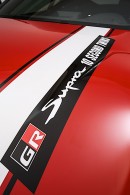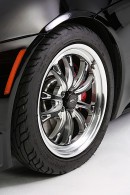At SEMA events, it’s customary for those attending with the purpose of showing something to get as crazy as they can. For this year’s event, we can already safely say craziness is through the roof. I mean, just look at these two Supras.
As most of you already know, a standard GR Supra baked in 2020 squeezes from its 3.0-liter, inline six-cylinder engine a total of 335 horsepower and 365 lb.-ft. of torque. Those are quite respectable numbers by all accounts, but not nearly enough for a show the magnitude of SEMA.
That’s why Toyota and its Toyota Motorsports Garage team went above and beyond to take those respectable numbers and turn them into ones worthy of a 10-second car.
By slapping onto the existing powerplant of a stock 2020 GR Supra 3.0 things like a single turbo, intercoolers, a catless downpipe, and a high-performance heat exchanger, the power output increased significantly, to a total of 620 horsepower and 590 lb.-ft. of torque.
But that was still not enough for SEMA, so instead of making just one of these, Toyota created two, meaning a combined output of 1,240 horsepower between them.
The two are called 10-Second Twins, and not solely because of some marketing stunt, but on account of one of them really going to the track. On the first run, Toyota says, it ended the quarter mile run in the mid-11-second range, but when it went out again, it froze the clock at 10:984.
All the above modifications, along with others that include upgraded rear axles, six-point racing seat belts and harness, and the Gazoo Racing-inspired paint scheme, were made within a $10,000 budget. It’s unclear if that covers both cars or just one of them.
The carmaker does not say what it plans to do with the Supras after SEMA is over, or whether we’re to expect a tuning program based on what was done for these two.
That’s why Toyota and its Toyota Motorsports Garage team went above and beyond to take those respectable numbers and turn them into ones worthy of a 10-second car.
By slapping onto the existing powerplant of a stock 2020 GR Supra 3.0 things like a single turbo, intercoolers, a catless downpipe, and a high-performance heat exchanger, the power output increased significantly, to a total of 620 horsepower and 590 lb.-ft. of torque.
But that was still not enough for SEMA, so instead of making just one of these, Toyota created two, meaning a combined output of 1,240 horsepower between them.
The two are called 10-Second Twins, and not solely because of some marketing stunt, but on account of one of them really going to the track. On the first run, Toyota says, it ended the quarter mile run in the mid-11-second range, but when it went out again, it froze the clock at 10:984.
All the above modifications, along with others that include upgraded rear axles, six-point racing seat belts and harness, and the Gazoo Racing-inspired paint scheme, were made within a $10,000 budget. It’s unclear if that covers both cars or just one of them.
The carmaker does not say what it plans to do with the Supras after SEMA is over, or whether we’re to expect a tuning program based on what was done for these two.

























